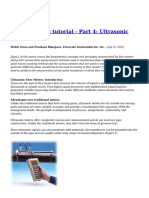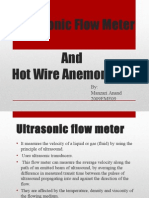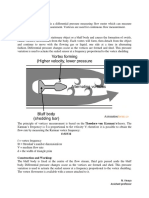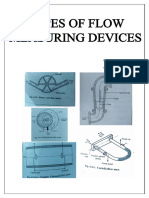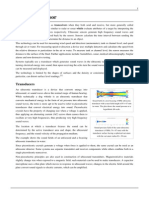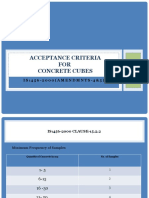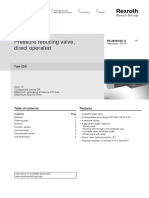0 ratings0% found this document useful (0 votes)
63 viewsWhat Is An Ultrasonic Flow Meter
What Is An Ultrasonic Flow Meter
Uploaded by
Pradeep Kumar SharmaAn ultrasonic flow meter uses ultrasound to measure the velocity and volume of liquid flowing through a pipe. It works by transmitting ultrasound signals upstream and downstream and measuring the speed difference between the signals, which increases with faster flow. There are different types of ultrasonic flow meters including Doppler velocity, radar, clamp-on, and level meters. Ultrasonic meters have advantages like no moving parts, bidirectional measurement, and suitability for dirty liquids. Their applications include wastewater, chemicals, and custody transfer of liquids.
Copyright:
© All Rights Reserved
Available Formats
Download as DOCX, PDF, TXT or read online from Scribd
What Is An Ultrasonic Flow Meter
What Is An Ultrasonic Flow Meter
Uploaded by
Pradeep Kumar Sharma0 ratings0% found this document useful (0 votes)
63 views5 pagesAn ultrasonic flow meter uses ultrasound to measure the velocity and volume of liquid flowing through a pipe. It works by transmitting ultrasound signals upstream and downstream and measuring the speed difference between the signals, which increases with faster flow. There are different types of ultrasonic flow meters including Doppler velocity, radar, clamp-on, and level meters. Ultrasonic meters have advantages like no moving parts, bidirectional measurement, and suitability for dirty liquids. Their applications include wastewater, chemicals, and custody transfer of liquids.
Original Title
What is an Ultrasonic Flow Meter
Copyright
© © All Rights Reserved
Available Formats
DOCX, PDF, TXT or read online from Scribd
Share this document
Did you find this document useful?
Is this content inappropriate?
An ultrasonic flow meter uses ultrasound to measure the velocity and volume of liquid flowing through a pipe. It works by transmitting ultrasound signals upstream and downstream and measuring the speed difference between the signals, which increases with faster flow. There are different types of ultrasonic flow meters including Doppler velocity, radar, clamp-on, and level meters. Ultrasonic meters have advantages like no moving parts, bidirectional measurement, and suitability for dirty liquids. Their applications include wastewater, chemicals, and custody transfer of liquids.
Copyright:
© All Rights Reserved
Available Formats
Download as DOCX, PDF, TXT or read online from Scribd
Download as docx, pdf, or txt
0 ratings0% found this document useful (0 votes)
63 views5 pagesWhat Is An Ultrasonic Flow Meter
What Is An Ultrasonic Flow Meter
Uploaded by
Pradeep Kumar SharmaAn ultrasonic flow meter uses ultrasound to measure the velocity and volume of liquid flowing through a pipe. It works by transmitting ultrasound signals upstream and downstream and measuring the speed difference between the signals, which increases with faster flow. There are different types of ultrasonic flow meters including Doppler velocity, radar, clamp-on, and level meters. Ultrasonic meters have advantages like no moving parts, bidirectional measurement, and suitability for dirty liquids. Their applications include wastewater, chemicals, and custody transfer of liquids.
Copyright:
© All Rights Reserved
Available Formats
Download as DOCX, PDF, TXT or read online from Scribd
Download as docx, pdf, or txt
You are on page 1of 5
What is an Ultrasonic Flow
Meter : Types and Its
Applications
The first ultrasonic flow meter was invented by Japanese physicist namely
“Shiego Satomura” in the year 1959. This flow meter uses Doppler technology
and the main intention of this meter is to deliver the analysis of blood flow.
After four years, the earliest flow meters have appeared in industrial
applications. At present, there are many manufacturing companies were
designing different types of clamp-on flow meters to measure the liquid flow
within a pipe. These meters use high-frequency sensors by penetrating
throughout the pipe wall as well as the liquid by using Doppler otherwise
transit time propagation method. So that fluid velocity and flow rate can be
determined.
What is an Ultrasonic Flow Meter?
Definition: An ultrasonic flow meter can be defined as, a meter that is used to
measure liquid velocity with ultrasound to analyze the volume of liquid flow.
This is a volumetric flow meter that needs bubble or minute particles within the
liquid flow. These meters are suitable in the applications of wastewater but
they will not work with drinking/distill water. So this type of flow meter is ideal
for the applications wherever chemical compatibility, low maintenance, and
low-pressure drop are required.
ultrasonic-flow-
meter
These meters will affect the audio properties of the liquid and also impact
through viscosity, density, temperature, etc. Like mechanical flow meters,
these meters do not include moving parts. The price of these meters will
change greatly so frequently it can be used and maintained at a low cost.
Ultrasonic Flow Meter Working Principle
An ultrasonic flow meter construction can be done by using upstream and
downstream transducers, sensor pipe and reflector. The working principle of
ultrasonic flow meter is, it uses sound waves to resolve the velocity of a liquid
within a pipe. There are two conditions in the pipe like no flow and flowing. In
the first condition, the frequencies of ultrasonic waves are transmitted into a
pipe & its indications from the fluid are similar. In the second condition, the
reflected wave’s frequency is dissimilar because of the Doppler Effect.
ultrasonic-
flow-meter-construction
Whenever the liquid flows in the pipe quickly, then the frequency shift can be
increased linearly. The transmitter processes the signals from the wave & its
reflections determine the flow rate. Transit time meters transmit & receive
ultrasonic waves in both the directions within the pipe. At no-flow condition,
the time taken to flow in between upstream & downstream in between
the transducers is the same.
Under these two flowing conditions, the wave at upstream will flow with less
speed than the downstream wave. As the liquid flows faster, the distinction
between the up & downstream times raises. The times of the upstream &
downstream processed by the transmitter to decide the flow rate.
Types of Ultrasonic Flow Meter
Ultrasonic flow meters available in the market are radar, Doppler velocity,
ultrasonic clamp-on, and ultrasonic level.
Doppler velocity type meters use reproduced ultrasonic noise to
calculate the liquid’s velocity.
Radar type meter employs microwave technology for transmitting small
pulses to reflect off a flowing surface back to the sensor for deciding
velocity.
Ultrasonic clamp-on type meter is ideal for applications wherever
accessing the pipe is difficult otherwise not possible.
Ultrasonic level type meter is ideal for determining the fluid level in both
open & closed channels.
Advantages of Ultrasonic Flow Meter
The advantages are
It does not block the path of liquid flow.
The o/p of this meter is different for density, viscosity & temperature of
the liquid.
The flow of liquid is bidirectional
The dynamic response of this meter is good.
The output of this meter is in analog form
Conservation of energy
It is appropriate for huge quality flow measurement
It is handy to fit and maintain
Versatility is good
There is no contact to liquid
There is no leakage risk
There are no moving parts, pressure loss
High accuracy
Disadvantages of Ultrasonic Flow Meter
The disadvantages are
It is expensive as compared with other mechanical flow meters.
Design of this meter is complex
Auditory parts of this meter are expensive.
These meters are complicated as compared with other meters, thus it
requires specialists for maintaining and repairing these meters
It cannot measure cement or concrete pipes one they rusted.
It doesn’t work once the pipe contains holes or bubbles in it
Can’t measure cement/concrete pipe or pipe with such material lining
Applications
The applications of ultrasonic flow meters include the following.
These meters are used in wastewater and dirty liquid applications
These meters are used wherever chemical compatibility, less
maintenance, and low-pressure drop are required.
These meters are used to measure the velocity of a liquid through
ultrasound to analyze volume flow.
These meters measure the disparity between the transit time of
ultrasonic pulses which transmits with the direction of liquid flow
The applications of these meters range from process to custody flow
This is one kind of device for volumetric flow measurement for liquids as
well as gases.
These are excellent alternatives for both vortex & electromagnetic
flowmeters.
FAQs
1). What is ultrasonic measurement?
Ultrasonic measurement is the contactless principle and used for measuring
the levels of corrosive, boiling and hot liquids.
2). How accurate are ultrasonic flow meters?
These meters provide extremely good accuracy and work well for dirt free flow
otherwise liquid flow with small particles.
3). What is the most accurate flow meter?
Coriolis mass flowmeters generate the most precise for most liquids but they
are costly.
4). What is a Doppler flow meter?
The Doppler flow meter use reflected ultrasonic noise to determine the liquid
velocity.
5). Who invented ultrasonic flow meter?
It was developed by Shigeo Satomura in the year 1959 for analysis of blood
flow and in 1963, the first meter was developed for industrial applications.
Thus, this is all about an overview of the ultrasonic flow meter . From the above
information finally, we can conclude that these meters are becoming more
popular because they are very simple to use and it is not essential to slash a
pipe to attain precise liquid flow measurements. These are suitable for
measuring both water and oil-based liquids. Here is a question for you, what is
a clamp-on ultrasonic flow meter?
You might also like
- 553C, 563C, and 573C Wheel Feller Buncher Hydraulic System: Front of Machine Behind CabDocument2 pages553C, 563C, and 573C Wheel Feller Buncher Hydraulic System: Front of Machine Behind Cabmrcruzito_2099No ratings yet
- Ultrasonic Sensor - Wikipedia, The Free EncyclopediaDocument3 pagesUltrasonic Sensor - Wikipedia, The Free Encyclopediamuna222100% (1)
- Study of Heat Transfer Coefficient in A Double Pipe Heat ExchangerDocument22 pagesStudy of Heat Transfer Coefficient in A Double Pipe Heat Exchangermahbub13320% (1)
- Lec.2 Mass Transfer PDFDocument18 pagesLec.2 Mass Transfer PDFاحمد حمید کارسول عزیزNo ratings yet
- FLOW SENSORDocument5 pagesFLOW SENSORta003744No ratings yet
- Doppler Shift Flow MetersDocument15 pagesDoppler Shift Flow MetersHonesto Raff IvanNo ratings yet
- Fluid Dynamics AssignmentDocument6 pagesFluid Dynamics AssignmentUzair ArslanNo ratings yet
- Types of Flow Measuring DevicesDocument19 pagesTypes of Flow Measuring DevicesRafat ShaikhNo ratings yet
- Ultrasonic MeasurementDocument11 pagesUltrasonic MeasurementPradeep Kumar PrakashNo ratings yet
- Flow Metering Tutorial Part 4 Ultrasonic Flow MetersDocument4 pagesFlow Metering Tutorial Part 4 Ultrasonic Flow MetersSenthil KumarNo ratings yet
- Ultrasonic Flow Meter Working and TypesDocument4 pagesUltrasonic Flow Meter Working and TypesCepi Sindang KamulanNo ratings yet
- FlowmetersDocument19 pagesFlowmeterstricky777No ratings yet
- Review and Operational Guidelines For Portable Ultrasonic FlowmetersDocument8 pagesReview and Operational Guidelines For Portable Ultrasonic FlowmetersvijayaNo ratings yet
- Flow Sensors: Garfield Smith Selvin GrayDocument17 pagesFlow Sensors: Garfield Smith Selvin GrayGarfield SmithNo ratings yet
- FC 0313 SpirePaperDocument8 pagesFC 0313 SpirePapercool_rdNo ratings yet
- Ultrasonic Flow meters (Transit Time vs Doppler)Document8 pagesUltrasonic Flow meters (Transit Time vs Doppler)leeruc28No ratings yet
- 7356-7927 devices&applicationDocument17 pages7356-7927 devices&application85cv7n7ddfNo ratings yet
- Ultrasonic FlowmeterDocument24 pagesUltrasonic FlowmeterSaitej Tst100% (1)
- Ultra Sonic Flow MeterDocument1 pageUltra Sonic Flow MetermusaveerNo ratings yet
- Ultra Sonic Fluid GrupDocument7 pagesUltra Sonic Fluid GrupAmirul Shahrin991109No ratings yet
- Ultrasonic Measuring DevicesDocument15 pagesUltrasonic Measuring DevicesSohail Aziz Ahmad Malik0% (1)
- A New Ultrasonic Flow Metering Technique Using Two Sing-Around Paths, Along With The Criticism of The Disadvantages Inherent in Conventional Ultrasonic Flow Metering TransducersDocument10 pagesA New Ultrasonic Flow Metering Technique Using Two Sing-Around Paths, Along With The Criticism of The Disadvantages Inherent in Conventional Ultrasonic Flow Metering Transducersvitor_pedroNo ratings yet
- Clamp-On Flow MeterDocument6 pagesClamp-On Flow MeterHanan Khan100% (1)
- Basic Flow MetersDocument3 pagesBasic Flow Metersladybuzz89No ratings yet
- Water Flow Meter TypesDocument2 pagesWater Flow Meter TypesMohamad AsrulNo ratings yet
- Flow Sensing Know HowDocument2 pagesFlow Sensing Know HowBulex ExtensiomNo ratings yet
- Laser Doppler AnemometryDocument4 pagesLaser Doppler Anemometryess_jNo ratings yet
- Inst Tools: Transit Time Flow Meter Advantages and DisadvantagesDocument7 pagesInst Tools: Transit Time Flow Meter Advantages and DisadvantagesArunNo ratings yet
- Flow Meter Slection GuideDocument8 pagesFlow Meter Slection GuidesushantNo ratings yet
- Flow Measurement TechnologyDocument59 pagesFlow Measurement TechnologyIamPedroNo ratings yet
- Flow MeasurementDocument10 pagesFlow Measurementnirvan93No ratings yet
- UNIT-3 (Ind Instru Notes)Document18 pagesUNIT-3 (Ind Instru Notes)rep domNo ratings yet
- Flexible Measurement From Outside The Pipe Without Process InterruptionDocument2 pagesFlexible Measurement From Outside The Pipe Without Process Interruptionborn2engineerNo ratings yet
- Basic Flow Measurements: InstrumentationDocument17 pagesBasic Flow Measurements: InstrumentationsasibhushanNo ratings yet
- CHE Facts 0709 PDFDocument1 pageCHE Facts 0709 PDFortegaroberNo ratings yet
- Different Types of Flow MeterDocument4 pagesDifferent Types of Flow MeterJihadah AyunanNo ratings yet
- Unit 3-Electrical Type Flow Meter: Fig 3.1 Electromagnetic Flowmeter Basic PrincipleDocument18 pagesUnit 3-Electrical Type Flow Meter: Fig 3.1 Electromagnetic Flowmeter Basic PrincipleARUNKUMAR MNo ratings yet
- Flow Meter Flow Mesurement Definition Uses of Flow Meter A TypesDocument3 pagesFlow Meter Flow Mesurement Definition Uses of Flow Meter A TypesMirza Zubair RazaNo ratings yet
- Measuring Instruments Used in PhysicsDocument22 pagesMeasuring Instruments Used in PhysicsScribdTranslationsNo ratings yet
- Ultrasonic Flow Meter PDFDocument7 pagesUltrasonic Flow Meter PDFsafia mohamedNo ratings yet
- Flow SensorsDocument2 pagesFlow Sensorssriyalakshmi005No ratings yet
- Instrumentation Basics - 02 - Flow MeasurementDocument62 pagesInstrumentation Basics - 02 - Flow MeasurementGhassan AL Hariri100% (1)
- Electromagnetic Flow Rate SensorDocument37 pagesElectromagnetic Flow Rate Sensorsnigdha.chaturvediNo ratings yet
- Flow Measurement BasicDocument87 pagesFlow Measurement BasicSrinivasarao YenigallaNo ratings yet
- Me Lab 1 Draft Group ReportDocument12 pagesMe Lab 1 Draft Group ReportAngelo PontivedraNo ratings yet
- A Small Diameter Ultrasonic Water Meter With Self-Diagnosis Function and Self-Adaptive TechnologyDocument13 pagesA Small Diameter Ultrasonic Water Meter With Self-Diagnosis Function and Self-Adaptive TechnologyXiong ChwNo ratings yet
- Flow MeterDocument10 pagesFlow Meterbanan maintechNo ratings yet
- Ultrasonic Flowmeter and Hot Wire AnemometerDocument32 pagesUltrasonic Flowmeter and Hot Wire AnemometerManzari AnandNo ratings yet
- 1 Flow MetersDocument16 pages1 Flow MetersVinaya NaralasettyNo ratings yet
- Electromagnetic Flow Meter - Accurate Durable and Reliable: Ultrasonik FlowmeterDocument3 pagesElectromagnetic Flow Meter - Accurate Durable and Reliable: Ultrasonik FlowmeterboringNo ratings yet
- Ultrasonik Flowmeter PDFDocument3 pagesUltrasonik Flowmeter PDFboringNo ratings yet
- Submitted By: Name:-Md. Rakibul Islam ID: - BME-1402003222 Program: - BME Section: - 3G Topic: - Subject: - ME-362Document7 pagesSubmitted By: Name:-Md. Rakibul Islam ID: - BME-1402003222 Program: - BME Section: - 3G Topic: - Subject: - ME-362দুর্জয় দুর্বারNo ratings yet
- Measurement 101 PDFDocument10 pagesMeasurement 101 PDFhelder.santos1114No ratings yet
- Mem MicroDocument16 pagesMem Micro119 HARSH SHIRKENo ratings yet
- CHE Facts 0709Document1 pageCHE Facts 0709Ivan Mario VillcaNo ratings yet
- Ultrasonic Meter TheoryDocument3 pagesUltrasonic Meter TheoryNattapong Pongboot100% (1)
- Flow Meter MeasurementDocument15 pagesFlow Meter Measurementkang1995No ratings yet
- Lecture-4 Flow: Ch-9: Flow Book: Introduction To Instrumentation, Sensors, and Process Control by William C DunnDocument32 pagesLecture-4 Flow: Ch-9: Flow Book: Introduction To Instrumentation, Sensors, and Process Control by William C DunnALviNo ratings yet
- Fluid Mechanics - Type of FlowmeterDocument9 pagesFluid Mechanics - Type of FlowmeterMuhammad ZulhilmiNo ratings yet
- Ultrasonic SensorDocument4 pagesUltrasonic SensorcostpopNo ratings yet
- Ultrasound Analysis for Condition Monitoring: Applications of Ultrasound Detection for Various Industrial EquipmentFrom EverandUltrasound Analysis for Condition Monitoring: Applications of Ultrasound Detection for Various Industrial EquipmentRating: 4.5 out of 5 stars4.5/5 (3)
- Water Remote Sensing: Advancements in Computer Vision Techniques for Water Remote SensingFrom EverandWater Remote Sensing: Advancements in Computer Vision Techniques for Water Remote SensingNo ratings yet
- Design of Pro. WTP (6.8 MLD) For BasavkalyanDocument27 pagesDesign of Pro. WTP (6.8 MLD) For BasavkalyanPradeep Kumar Sharma100% (2)
- Acceptance Criteria FOR Concrete Cubes: I S: 4 5 6 - 2 0 0 0 (A M E N D M N T S - 4 & 5)Document7 pagesAcceptance Criteria FOR Concrete Cubes: I S: 4 5 6 - 2 0 0 0 (A M E N D M N T S - 4 & 5)Pradeep Kumar Sharma100% (2)
- Building Estimation: Quantity SheetDocument20 pagesBuilding Estimation: Quantity SheetAjay katkarNo ratings yet
- Presentation On Contract ManagementDocument17 pagesPresentation On Contract ManagementPradeep Kumar SharmaNo ratings yet
- Energy Sav HVAC SystemDocument16 pagesEnergy Sav HVAC SystemrapidSHVNo ratings yet
- Rotork ManpowerDocument4 pagesRotork Manpowermar mayoNo ratings yet
- Solucionario - Mecanica de Fluidos - Sexta Edicion - Robert L Mott PDFDocument298 pagesSolucionario - Mecanica de Fluidos - Sexta Edicion - Robert L Mott PDFmoquete75% (8)
- Aerodynamic Measurements at Low Reynolds Numbers For Fixed Wing Micro-Air VehiclesDocument33 pagesAerodynamic Measurements at Low Reynolds Numbers For Fixed Wing Micro-Air VehiclesPradeep RoyNo ratings yet
- Iso 4020 2001Document15 pagesIso 4020 2001leensppNo ratings yet
- Friction Losses - 1.2 MDocument3 pagesFriction Losses - 1.2 MDivision no.3 cdoNo ratings yet
- 77-1141 Valve Selection and SizingDocument20 pages77-1141 Valve Selection and SizingAntonio LebrunNo ratings yet
- Introduction To LNG & Material Used in LNG ServicesDocument104 pagesIntroduction To LNG & Material Used in LNG ServicesVishaka ThekkedathNo ratings yet
- Ficha Tecnica 390 395 PDFDocument2 pagesFicha Tecnica 390 395 PDFRichard Franklin Pacheco QuiscaNo ratings yet
- Axial Piston Variable Motor A6VM: RE 91 604/05.06 1/76 Replaces: 06.03Document76 pagesAxial Piston Variable Motor A6VM: RE 91 604/05.06 1/76 Replaces: 06.03Александр БулдыгинNo ratings yet
- Spurs in RiverDocument4 pagesSpurs in RiverAbhijit PatowaryNo ratings yet
- ME1130 Mechanism of SolidificationDocument15 pagesME1130 Mechanism of SolidificationShivam RajNo ratings yet
- De Ethanizer ColumnDocument24 pagesDe Ethanizer Columnrohit agrawalNo ratings yet
- 2 Timken Preços (U$5,30) 07.03.2022Document4,306 pages2 Timken Preços (U$5,30) 07.03.2022Gleyson SousaNo ratings yet
- Fet - Ci - Lecture - Notes - Prof - Quamrul - Hassan - CE702 Design of WeirDocument53 pagesFet - Ci - Lecture - Notes - Prof - Quamrul - Hassan - CE702 Design of Weiratchyut sharmaNo ratings yet
- Exercise Set 2newDocument16 pagesExercise Set 2newNurye NigusNo ratings yet
- AHU Technical DataSheetDocument9 pagesAHU Technical DataSheetazNo ratings yet
- Dam-Break Flows During Initial Stage Using SWE and RANS ApproachesDocument10 pagesDam-Break Flows During Initial Stage Using SWE and RANS ApproachesAndrea GranelliNo ratings yet
- c680 PDFDocument43 pagesc680 PDFRahul ThakurNo ratings yet
- Peristaltic Flow of Blood Through Coaxial Vertical Channelwith Effect of Magnetic Field: Blood Flow StudyDocument12 pagesPeristaltic Flow of Blood Through Coaxial Vertical Channelwith Effect of Magnetic Field: Blood Flow StudyAnonymous pKuPK3zUNo ratings yet
- Seminar ReportDocument36 pagesSeminar ReportTEMY PETER100% (3)
- NotchFlo™ DST ValveDocument2 pagesNotchFlo™ DST ValveAhmed KhairyNo ratings yet
- FLOW IN CHANNELS - GVF - Part 3Document22 pagesFLOW IN CHANNELS - GVF - Part 3vishal saranNo ratings yet
- ZDR10 Re26585Document8 pagesZDR10 Re26585Tayfun GunalNo ratings yet
- FVG FVPG FD R22Document154 pagesFVG FVPG FD R22thanhlong2005No ratings yet
- Stvu-08a - Stfu-08aDocument6 pagesStvu-08a - Stfu-08atecnicomanelNo ratings yet









